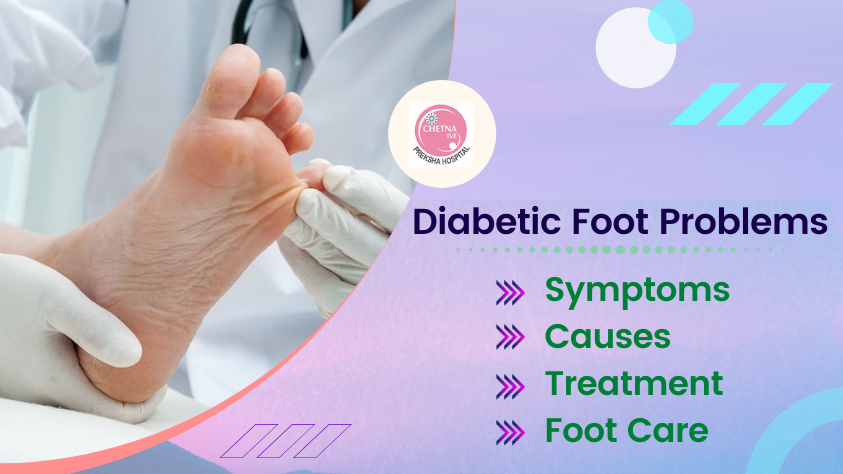
There are various studies showing people with diabetes are prone to foot problems that occur possibly due to prolonged periods of high blood pressure.
It is casual and can happen to anyone as studies reveal that almost 80% of people with diabetes have numbness in their feet aka peripheral diabetic neuropathy.
Careful because diabetic neuropathy and peripheral vascular disease are giantly concerned with foot problems that occur, and both can have serious complications.
However, Diabetes is observed as a disease that arises in human beings due to insufficient insulin production or low sensitivity to insulin.
“Insulin is an essential hormone that is responsible for helping cells absorb sugar from the blood to use for energy.”
Signs/Symptoms of Diabetic Foot Problems
The foot symptoms of diabetes aren’t hard to judge as it is widely focal to the foot.
The symptoms classification differs and varies from person to person and can depend on the specific issues a person is experiencing at the time.
Typically, the symptoms might include:
- a loss of feeling
- numbness or tingling sensation
- blisters or other wounds without pain
- skin discoloration and temperature changes
- red streaks
- wounds with or without drainage
- painful tingling
- staining on socks
(In case the infection develops, it is possible may person also experience some of the following)
- fever
- chills
- uncontrollable blood sugar
- shaking
- shock
- redness
Caution: A person experiencing diabetic foot problems with symptoms of an infection should seek emergency treatment with good diabetologist doctors in Jodhpur.
What Are Some Common Foot Problems With Diabetes?
Diabetic Neuropathy and Peripheral Vascular Disease are the main cause of diabetic foot problems. The following foot problems are an indication of such diseases.
- Athlete’s foot – Athlete’s foot is a fungus that causes itching, redness, and cracking.
- Fungal infection of nails – Discolored (yellowish-brown or opaque), thick, and brittle, and may separate from the rest of your nail.
- Calluses – A callus is a buildup of hard skin, usually on the underside of the foot.
- Corns – A corn is a buildup of hard skin near a bony area of a toe or between toes.
- Blisters – Blisters can form when your shoes rub the same spot on your foot.
- Bunions – A bunion forms when your big toe bends toward your second toe.
- Dry skin – Dry skin can crack, which can allow germs to enter.
- Diabetic ulcers – A foot ulcer is a break in the skin or a deep sore.
- Hammertoes – A hammertoe is a toe that is bent because of a weakened muscle.
- Ingrown toenails – It happens when the edges of the nail grow into your skin.
- Plantar warts – Plantar warts look like calluses on the ball of the foot or on the heel.
Tabular show age group-wise (male and female) common diabetic and diabetic foot problems stats:
| Age Group | Diabetes (M) | Diabetic Foot (M) | Diabetes (F) | Diabetic Foot (F) |
| <20 | 10% | NA | 5% | NA |
| 21-40 | 65% | 5% | 30% | 2% |
| 41-60 | 85% | 20% | 60% | 4% |
| 61-80 | 70% | 15% | 45% | 3% |
| >80 | 1% | NA | 2% | NA |
The percentages shown are just estimation and have fewer accuracy.
Complications of Diabetic Foot Problems
Diabetic neuropathy and peripheral vascular sickness are not kidding conditions that a specialist should screen intently.
Both reason complexities that can have genuine, ongoing impacts. These complications may include:
- foot ulcers or wounds that don’t mend
- diseases, including skin contaminations, bone diseases, and abscesses
- gangrene, when a disease causes tissue demise
- foot disfigurement
- Charcot’s foot, which adjusts the state of the feet as bones in the foot and toe-shift or breaks
A doctor may suggest amputation if a person develops gangrene!
Tips for Diabetic Foot Care
It is great taking care of our body with precise consultation by someone who knows about it. People with diabetic foot problems can seek doctors for preventing foot problems. They suggest kind ways to keep your feet healthy.
They can suggest the following steps:
- Check the feet each day
- Wash the feet daily
- Wear supportive shoes and socks
- Promote blood flow to the feet
- Trim nails carefully
- Care for corns and bunions
- Protect feet from extreme temperatures
- Receive regular examinations on the feet
- Control blood sugar
- Avoid smoking and alcohol consumption
Talk to our diabetologist doctors for accurate and complete diabetic foot prevention care tips.
Also Read:- What are the common signs and symptoms of diabetes?
Diabetic Foot Treatment in Jodhpur
Preksha Hospital, the best private hospital in Jodhpur has a specialized center for diabetes with dedicated and specially trained Diabetologists and Dieticians with cross-referral support from other Medical specialties.
Book an appointment today.
